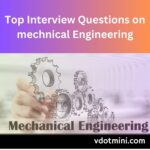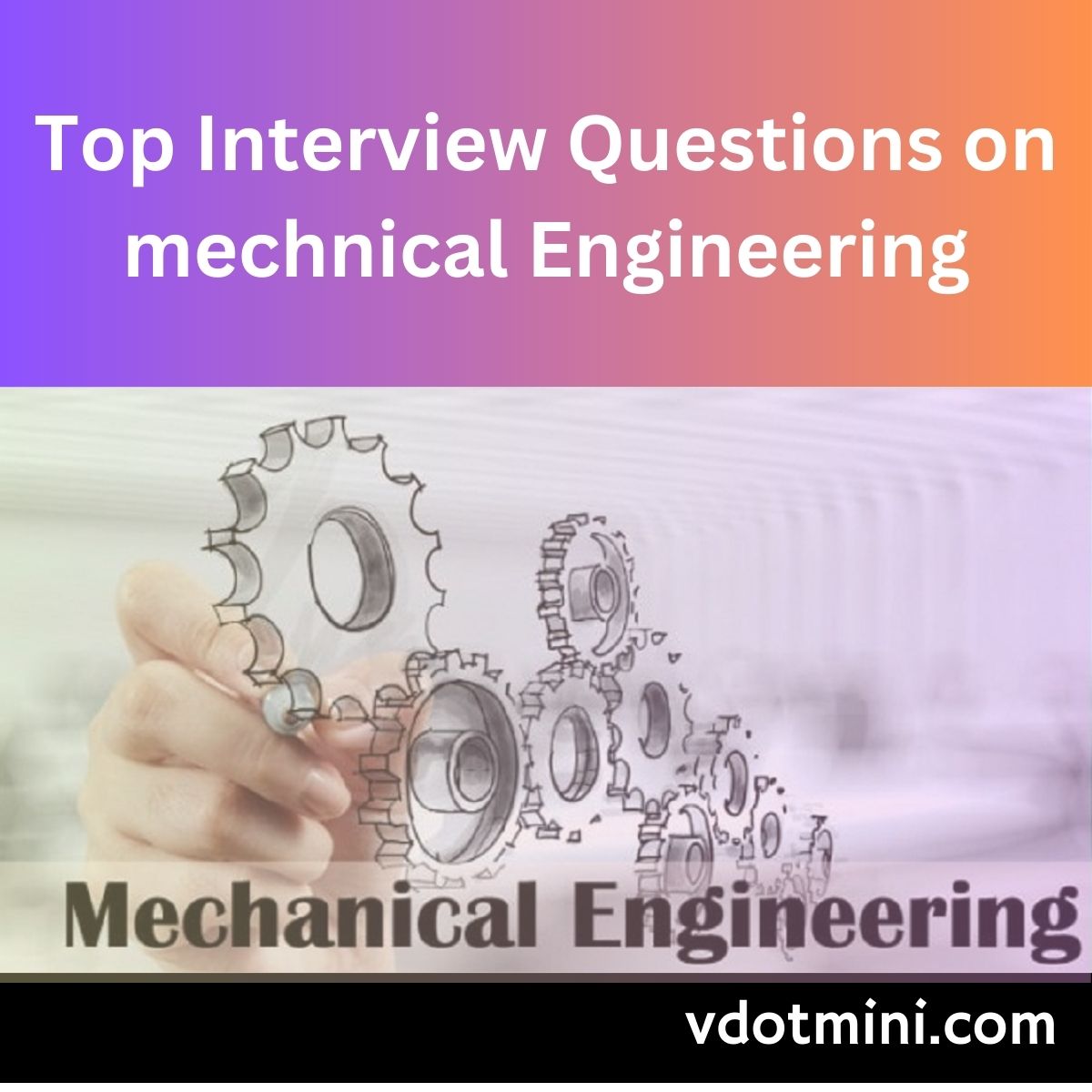Top Interview Questions on Mechanical Engineering
For Jobs and Interview questions, Click here
For Job Tips, career Tips, Interview Questions, Road maps, Click here
Top Interview Questions on Civil Engineering
What is Mechanical Engineering?
Mechanical Engineering is a branch of engineering that involves the design, analysis, manufacturing, and maintenance of mechanical systems.
What are the different types of loadings in mechanical engineering?
The different types of loadings in mechanical engineering include static loading, dynamic loading, and thermal loading.
What is stress and strain?
Stress is the internal resistance of a material to deformation, while strain is the measure of deformation in a material.
What is the difference between stress and pressure?
Stress is a measure of the internal forces acting within a material, while pressure is a measure of the external forces acting on a surface.
What is the difference between tensile stress and compressive stress?
Tensile stress is the stress that tends to pull a material apart, while compressive stress is the stress that tends to push a material together.
Explain the concept of Young’s Modulus.
Young’s Modulus is a measure of the stiffness of a material. It is defined as the ratio of stress to strain in a material under elastic deformation.
What is the difference between ductile and brittle materials?
Ductile materials can undergo significant plastic deformation before failure, while brittle materials fail without significant plastic deformation.
What is the difference between fatigue and creep?
Fatigue is the failure of a material under cyclic loading, while creep is the gradual deformation of a material under constant loading over time.
Explain the concept of thermal expansion.
Thermal expansion is the tendency of a material to expand or contract in response to changes in temperature.
What is the difference between a closed-loop and an open-loop system?
A closed-loop system has a feedback mechanism to control the output based on the input, while an open-loop system does not have feedback.
Explain the working principle of a four-stroke engine.
A four-stroke engine operates on the principle of intake, compression, power, and exhaust strokes to convert fuel into mechanical energy.
What is the difference between a two-stroke and a four-stroke engine?
A two-stroke engine completes the four-stroke cycle in two strokes of the piston, while a four-stroke engine completes the cycle in four strokes.
What is the Carnot cycle?
The Carnot cycle is a theoretical thermodynamic cycle that represents the most efficient heat engine possible operating between two temperature reservoirs.
Explain the working principle of a hydraulic system.
A hydraulic system uses a liquid, usually oil, to transmit power and perform mechanical tasks.
What is the difference between impulse and reaction turbines?
Impulse turbines are driven by the force of a fluid’s momentum, while reaction turbines are driven by the fluid pressure changes as it flows through the turbine.
Explain the concept of entropy.
Entropy is a measure of the disorder or randomness in a system. In thermodynamics, it is a measure of the unavailable energy in a closed system for conversion into mechanical work.
What is the difference between an ideal gas and a real gas?
An ideal gas follows the ideal gas law, while a real gas deviates from the ideal gas law under certain conditions.
Explain the concept of mechanical advantage.
Mechanical advantage is the ratio of the output force to the input force in a mechanical system.
What is the difference between impulse and momentum?
Impulse is the change in momentum of an object, while momentum is the product of an object’s mass and velocity.
Explain the working principle of a refrigeration cycle.
A refrigeration cycle uses the principles of evaporation and condensation to remove heat from a space and transfer it to another location.
What is the difference between brazing and welding?
Brazing uses a filler material with a lower melting point than the base materials, while welding melts the base materials to join them together.
Explain the concept of gear ratio.
Gear ratio is the ratio of the number of teeth on the driving gear to the number of teeth on the driven gear in a gear system.
What is the difference between a screw and a bolt?
A screw is used to fasten objects together by turning into a threaded hole, while a bolt is used with a nut to fasten objects together.
Explain the concept of torque.
Torque is the measure of the rotational force applied to an object, calculated as the product of the force and the distance from the axis of rotation.
What is the difference between a centrifugal pump and a reciprocating pump?
A centrifugal pump uses centrifugal force to move fluid, while a reciprocating pump uses a piston or diaphragm to create pressure and move fluid.
Explain the working principle of a diesel engine.
A diesel engine operates on the principle of compression ignition, where fuel is injected into a compressed air mixture, causing combustion.
What is the difference between a closed die forging and an open die forging?
In closed die forging, the metal is enclosed within dies that shape it into the desired form, while in open die forging, the metal is shaped between flat dies.
Explain the concept of thermal conductivity.
Thermal conductivity is a measure of a material’s ability to conduct heat. It is the rate at which heat is transferred through a unit area of a material.
What is the difference between a rivet and a bolt?
A rivet is a permanent fastener that is installed by deforming it to hold two pieces of material together, while a bolt is a removable fastener that uses a nut to secure it.
Explain the concept of heat treatment.
Heat treatment is a process used to alter the physical and mechanical properties of a material by heating and cooling it in a controlled manner.
What is the difference between a centrifugal compressor and a reciprocating compressor?
A centrifugal compressor uses centrifugal force to compress gas, while a reciprocating compressor uses a piston to compress gas.
Explain the working principle of a gas turbine engine.
A gas turbine engine operates on the principle of burning fuel in a high-pressure chamber to generate hot gases that drive a turbine.
What is the difference between a worm gear and a spur gear?
A worm gear has a screw-like structure that meshes with a gear, providing high gear reduction ratios, while a spur gear has teeth that mesh directly with another gear.
Explain the concept of hydraulic resonance.
Hydraulic resonance is a phenomenon that occurs when the natural frequency of a hydraulic system matches the frequency of an external force, leading to increased vibration and potential damage.
What is the difference between ductility and malleability?
Ductility is the ability of a material to deform under tensile stress, while malleability is the ability of a material to deform under compressive stress.
Explain the concept of critical speed in rotating machinery.
Critical speed is the speed at which a rotating shaft experiences excessive vibration due to resonance with natural frequencies.
What is the difference between a boiler and a heat exchanger?
A boiler is a device used to generate steam by heating water, while a heat exchanger is a device used to transfer heat from one fluid to another.
Explain the concept of specific heat capacity.
Specific heat capacity is the amount of heat required to raise the temperature of a unit mass of a substance by one degree Celsius.
What is the difference between a pump and a compressor?
A pump is used to move liquids, while a compressor is used to move gases.
Explain the working principle of a Stirling engine.
A Stirling engine operates on the principle of cyclic compression and expansion of a working fluid at different temperature levels.
What is the difference between a pneumatic system and a hydraulic system?
A pneumatic system uses compressed air to transmit power, while a hydraulic system uses compressed fluid, usually oil.
Explain the concept of gear train.
A gear train is a series of gears that transmit motion and torque from one shaft to another.
What is the difference between a closed loop and an open loop control system?
A closed-loop control system uses feedback to adjust the output based on the input, while an open-loop control system does not use feedback.
Explain the concept of heat exchanger effectiveness.
Heat exchanger effectiveness is a measure of how effectively a heat exchanger transfers heat from one fluid to another.
What is the difference between laminar flow and turbulent flow?
Laminar flow is smooth and orderly, with layers of fluid moving parallel to each other, while turbulent flow is chaotic, with mixing and eddies.
Explain the concept of moment of inertia.
Moment of inertia is a measure of an object’s resistance to changes in its rotation.
What is the difference between a condenser and an evaporator?
A condenser is used to condense a gas into a liquid, while an evaporator is used to evaporate a liquid into a gas.
Explain the working principle of a hydraulic jack.
A hydraulic jack uses a hydraulic cylinder to lift heavy loads by applying pressure to a small piston, which then exerts a larger force on a larger piston.
What is the difference between a pneumatic actuator and a hydraulic actuator?
A pneumatic actuator uses compressed air to produce motion, while a hydraulic actuator uses compressed fluid, usually oil.
Explain the concept of resonance in mechanical systems.
Resonance is a phenomenon that occurs when a system is subjected to a periodic force at its natural frequency, leading to a large amplitude response.
What is the difference between a boiler and a heat exchanger?
A boiler is a device used to generate steam by heating water, while a heat exchanger is a device used to transfer heat from one fluid to another.
Explain the concept of specific heat capacity.
Specific heat capacity is the amount of heat required to raise the temperature of a unit mass of a substance by one degree Celsius.
What is the difference between a pump and a compressor?
A pump is used to move liquids, while a compressor is used to move gases.
Explain the working principle of a Stirling engine.
A Stirling engine operates on the principle of cyclic compression and expansion of a working fluid at different temperature levels.
What is the difference between a pneumatic system and a hydraulic system?
A pneumatic system uses compressed air to transmit power, while a hydraulic system uses compressed fluid, usually oil.
Explain the concept of gear train.
A gear train is a series of gears that transmit motion and torque from one shaft to another.
What is the difference between a closed loop and an open loop control system?
A closed-loop control system uses feedback to adjust the output based on the input, while an open-loop control system does not use feedback.
Explain the concept of heat exchanger effectiveness.
Heat exchanger effectiveness is a measure of how effectively a heat exchanger transfers heat from one fluid to another.
What is the difference between laminar flow and turbulent flow?
Laminar flow is smooth and orderly, with layers of fluid moving parallel to each other, while turbulent flow is chaotic, with mixing and eddies.
Explain the concept of moment of inertia.
Moment of inertia is a measure of an object’s resistance to changes in its rotation.
What is the difference between a condenser and an evaporator?
A condenser is used to condense a gas into a liquid, while an evaporator is used to evaporate a liquid into a gas.
Explain the working principle of a hydraulic jack.
A hydraulic jack uses a hydraulic cylinder to lift heavy loads by applying pressure to a small piston, which then exerts a larger force on a larger piston.
What is the difference between a pneumatic actuator and a hydraulic actuator?
A pneumatic actuator uses compressed air to produce motion, while a hydraulic actuator uses compressed fluid, usually oil.
Explain the concept of resonance in mechanical systems.
Resonance is a phenomenon that occurs when a system is subjected to a periodic force at its natural frequency, leading to a large amplitude response.
What is the difference between a reciprocating engine and a rotary engine?
A reciprocating engine converts linear motion of pistons into rotary motion, while a rotary engine produces rotary motion directly.
Explain the concept of specific speed in pumps.
Specific speed is a dimensionless number that characterizes the geometry and operating conditions of a pump.
What is the difference between a ball bearing and a roller bearing?
A ball bearing uses balls to reduce friction between two surfaces, while a roller bearing uses cylindrical rollers.
Explain the working principle of a carburetor.
A carburetor mixes air and fuel in the correct ratio for combustion in an internal combustion engine.
What is the difference between a camshaft and a crankshaft?
A camshaft is used to operate the valves in an internal combustion engine, while a crankshaft converts linear motion into rotary motion.
Explain the concept of hydrostatics.
Hydrostatics is the study of fluids at rest and the forces acting on them.
What is the difference between a finned tube and a plain tube?
A finned tube has fins attached to increase the surface area for heat transfer, while a plain tube has no fins.
Explain the working principle of a steam turbine.
A steam turbine uses high-pressure steam to rotate blades, which in turn rotate a shaft to generate power.
What is the difference between a closed loop and an open loop system?
A closed-loop system has feedback, while an open-loop system does not.
Explain the concept of thermal efficiency.
Thermal efficiency is the ratio of the useful work output to the heat input in a system.
What is the difference between a gear pump and a vane pump?
A gear pump uses gears to move fluid, while a vane pump uses vanes.
Explain the working principle of a clutch.
A clutch is used to engage and disengage the transmission from the engine in a vehicle.
What is the difference between a pump and a compressor?
A pump moves liquids, while a compressor moves gases.
Explain the concept of friction.
Friction is the force resisting the relative motion of solid surfaces, fluid layers, and material elements sliding against each other.
What is the difference between a synchronous motor and an induction motor?
A synchronous motor rotates at a speed equal to the frequency of the applied AC voltage, while an induction motor rotates at a speed slightly less than the synchronous speed.
Explain the working principle of a gas turbine.
A gas turbine uses the energy of expanding gas to rotate a turbine, which in turn drives a compressor and generates power.
What is the difference between a pump and a compressor?
A pump is used to move liquids, while a compressor is used to move gases.
Explain the concept of specific heat capacity.
Specific heat capacity is the amount of heat required to raise the temperature of a unit mass of a substance by one degree Celsius.
What is the difference between a reciprocating engine and a rotary engine?
A reciprocating engine converts linear motion of pistons into rotary motion, while a rotary engine produces rotary motion directly.
Explain the working principle of a carburetor.
A carburetor mixes air and fuel in the correct ratio for combustion in an internal combustion engine.
What is the difference between a camshaft and a crankshaft?
A camshaft is used to operate the valves in an internal combustion engine, while a crankshaft converts linear motion into rotary motion.
Explain the concept of hydrostatics.
Hydrostatics is the study of fluids at rest and the forces acting on them.
What is the difference between a finned tube and a plain tube?
A finned tube has fins attached to increase the surface area for heat transfer, while a plain tube has no fins.
Explain the working principle of a steam turbine.
A steam turbine uses high-pressure steam to rotate blades, which in turn rotate a shaft to generate power.
What is the difference between a closed loop and an open loop system?
A closed-loop system has feedback, while an open-loop system does not.
Explain the concept of thermal efficiency.
Thermal efficiency is the ratio of the useful work output to the heat input in a system.
What is the difference between a gear pump and a vane pump?
A gear pump uses gears to move fluid, while a vane pump uses vanes.
Explain the working principle of a clutch.
A clutch is used to engage and disengage the transmission from the engine in a vehicle.
What is the difference between a pump and a compressor?
A pump moves liquids, while a compressor moves gases.
Explain the concept of friction.
Friction is the force resisting the relative motion of solid surfaces, fluid layers, and material elements sliding against each other.
What is the difference between a synchronous motor and an induction motor?
A synchronous motor rotates at a speed equal to the frequency of the applied AC voltage, while an induction motor rotates at a speed slightly less than the synchronous speed.
Explain the working principle of a gas turbine.
A gas turbine uses the energy of expanding gas to rotate a turbine, which in turn drives a compressor and generates power.
What is the difference between a pump and a compressor?
A pump is used to move liquids, while a compressor is used to move gases.
Explain the concept of specific heat capacity.
Specific heat capacity is the amount of heat required to raise the temperature of a unit mass of a substance by one degree Celsius.
What is the difference between a reciprocating engine and a rotary engine?
A reciprocating engine converts linear motion of pistons into rotary motion, while a rotary engine produces rotary motion directly.
Explain the working principle of a carburetor.
A carburetor mixes air and fuel in the correct ratio for combustion in an internal combustion engine.









